The University of Indianapolis first recognized UIndy Pride as an official registered student organization in 1997, according to The Reflector’s Feb. 4, 1997 issue. The LGBTQ community at the university is given more support from faculty and administration, according to Director of University Events and UIndy alumni Jeffery Barnes.
In the late 90s, according to Barnes, there were not as many people “out”—or openly LGBTQ—at the university. There were not as many resources for LGBTQ students on campus at the time and students struggled with finding people to talk to about their identities, he said.
“There weren’t many people out at all. There were maybe like, four or five students who were out that I’m aware of. And then only to small groups of people like to their close friends most likely,” Barnes said. “There weren’t any resources for people to go to and one of my friends in particular really struggled and he just didn’t really have anyone to go to. And I came out and kind of had similar issues.”

The struggles students faced being a part of the LGBTQ community prompted people to start a group that would eventually turn into UIndy Pride, Barnes said. As a founding member of UIndy Pride, which was originally founded as “The Pride” on campus, Barnes said that with not as much access to electronic advertising the group had to use flyers to advertise on bulletin boards and windows.
Senior anthropology major and Co-Chair for UIndy Pride Theo Saxe said that being a part of UIndy Pride has helped with being a queer person on campus. UIndy Pride functions as a support system for people who otherwise are not able to find a space for support in other capacities on campus. In terms of areas growth for UIndy, Saxe said there is a lack of understanding and representation in some respects, particularly within the university’s staff.
“If you see a little sticker that says it’s an LGBTQ safe space, that doesn’t always necessarily mean that it’s true. I’ve had my own fair share of experiences where I’ll see a sticker like that, I’m like, ‘Oh, awesome.’ And I get to the actual class and they’ll say things that’s really not something you should say,” Saxe said. “I know a lot of classes that I’ve been in, in particular that are supposed to be about the LGBTQ community, are taught by straight people and as a queer person, you always end up having to correct them on things which feels awkward more often than not.”
Barnes said in general, LGBTQ students are more widely accepted on campus as well as faculty and staff that are out, which was not the case when he was a student. Pride members, when the organization first applied to be an RSO, would put flyers around campus that then would be defaced, according to Barnes. The success of the annual drag show at UIndy is also a large milestone for the LGBTQ community on campus, Barnes said.
“Over the years the administration changed the language in the non-discrimination clause or statement to include LGBTQ individuals,” Barnes said. “So there’s been a lot of strides like that that have made the difference and we’ve come a long way.”
Barnes said that reaching beyond the university, the LGBTQ community is going through a period in history where the pendulum might be swinging against the community. Continuing education within the curriculum surrounding the LGBTQ community is important to educate the public on the needs of the community, he said.
“I think we need to continue to be strong and support each other and provide whatever educational programming we can [in order] to keep educating the public to our concerns and our needs,” Barnes said.






